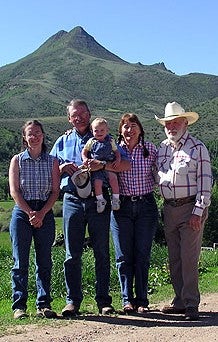Pat O’Toole is a rancher and farmer at Ladder Livestock, a sixth-generation family operation on the Little Snake River along the Wyoming-Colorado border. A leader in collaborative conservation, Pat is engaged in a number of innovative land and water conservation efforts in his capacity as president of the Family Farm Alliance and a member of the AGree advisory board.
This past September, Pat co-authored an AGree paper with Dan Keppen, Executive Director of Family Farm Alliance. The paper – Securing the Future of Western Agriculture: A Perspective of Western Producers – addresses some broad challenges facing the global food and agriculture system. Namely, the need to meet future demands for food while simultaneously enhancing water, soil and other natural resources.
I recently had the opportunity to visit Pat’s ranch to get a sense of these challenges that he and other Western producers face, and to learn more about what Pat is doing to overcome these challenges on his ranch. I asked him to give us a recap of our discussion and to tell us more about his vision for the future.
What do you consider to be some of the biggest challenges facing Western producers?
Today we are facing some critical food supply issues, and agriculture is expected to not only produce food to feed the nation, but also to expand their conservation practices.
As the West’s population has grown, issues like water security have become increasingly important – and polarized. But by working with groups like Environmental Defense Fund, The Nature Conservancy and Trout Unlimited, we are finding that we have a lot more in common than not. It’s within this common ground that we are coming up with some really interesting and innovative solutions to tackle these problems.
What are some specific challenges you face on your ranch?
Every farm and every farmer has a different individual experience based on their land. My family has lived and thrived off of this land for six generations, but today we are trying to figure out how to survive moving into the future. We keep hearing that we need to improve water quality, water quantity and endangered species habitat, but we can’t do it alone. Agriculture can’t be expected to bear all the burdens of a growing population and constrained natural resources.
Take water for example – if farmers fallow great swaths of farmland so that water can be transferred to meet other demands, this would have grave implications for our country’s ability to produce enough food for everyone. Instead, we need to take a close look at our irrigation practices to see which ones are appropriate in a particular landscape and can work for farmers and for the environment. On my ranch, we’ve tried delivering water to crops through flood irrigation at the right times and quantities to simultaneously recharge rivers and wetlands at critical times for wildlife. We’ve had some promising results.
What does collaborative conservation mean to you?
I have found from my experience working with various partners through AGree that it’s all about respect. Finger pointing is discouraging to us farmers. We can’t blame our environmental problems on farmers. We have to work together and accept each other’s expertise.

Pat and his family have been working with the U.S. Fish and Wildlife Service’s Partners Program for a number of years on a project to help fish and improve irrigation on Battle Creek. The project includes a number of structures that enhance habitat for fish, especially Colorado Cutthroat Trout, and provide improved flood irrigation for native hay meadows. This, in turn, benefits the wetlands that support bird populations.
See more photos on the Ladder Ranch blog.
It’s when people sit down and put their heads together – being cognizant of the farmer’s burden to balance food production and environmental health – that I find we come up with some really intelligent solutions. We just have to keep sharing our experiences and learning from one another.
What is your vision or hope for the future?
My hope is that Western producers have and will continue to have the water, materials and resources we need to protect human health and our environment. That is how I define sustainability.
Are you optimistic that we can achieve this?
I am generally optimistic because I have seen that it can work. If you look in the Upper Rocky Mountains or in the Central Valley of California, you can find examples of farmers adjusting their irrigation practices to put more water in the river channel, helping protect habitat for fish and migratory birds. On my own ranch, I am experimenting with projects to improve stream flows and restore flood plains that will hopefully benefit my farm and the wildlife on it.
Wendell Berry said it best when he wrote, “You can’t save the land without the people; to save either, you have to save both.” With all the great minds I know working on this, I am hopeful that we can achieve it.










